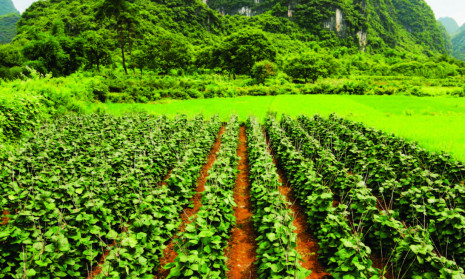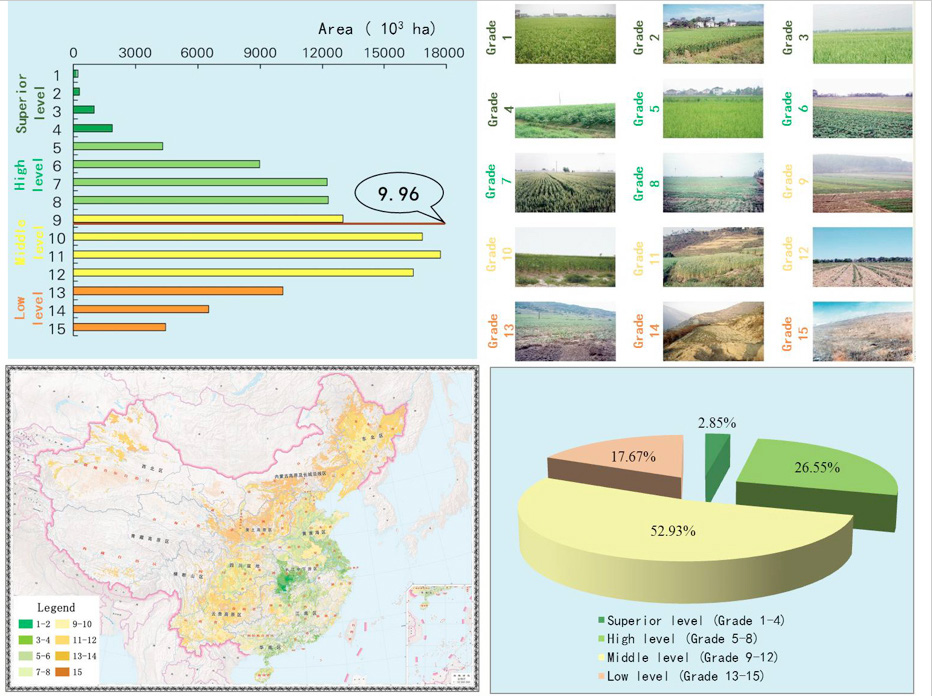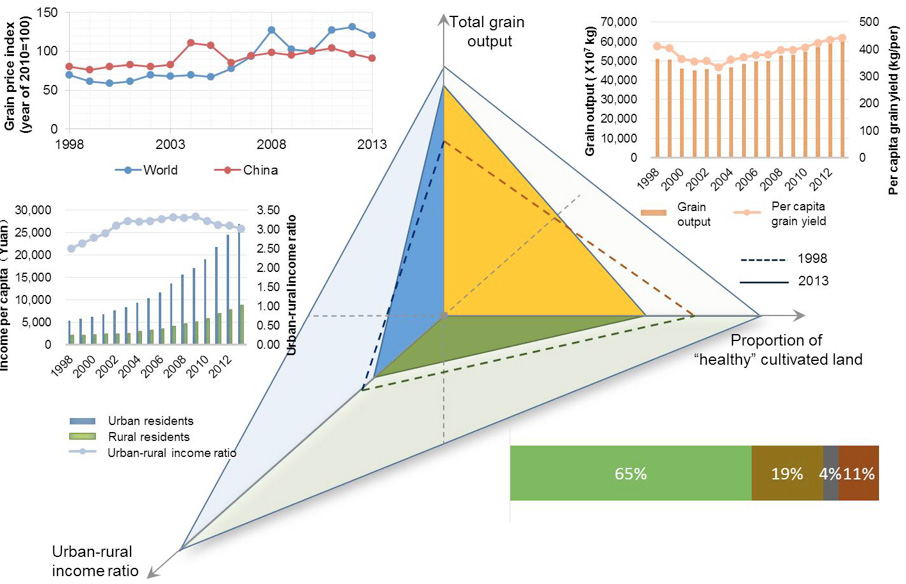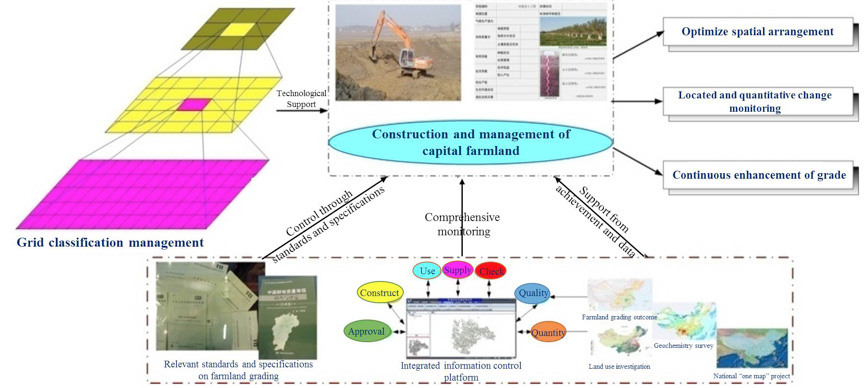Status, problem and strategy of capital farmland development in China

Since the founding of the People’s Republic of China, the construction of irrigation and water conservation projects reached a peak in the 1960s and 1970s with farmland irrigation area of about 45 Mha (1) nationwide. This provides the base from which farmland can achieve its potential. In the 1980s and 1990s, as a result of limited and fragmented investment in the long term, this in turn gives rise to widespread agricultural infrastructure disrepair and functional degradation.
Given the tremendous food demands, the State Council formulated the capital farmland protection system at the national level in 1994. This system has ensured strict protection on more than 104 Mha of farmland, accounting for over 80% the total area of farmland to meet minimum need for food. In the late 1990s, land consolidation was practiced in order to improve the quality of capital farmland. It is a more positive way for the effective supply of farm produce, whilst ensuring sustainable use of resources. Almost 13.33 Mha (4) capital farmland has been constructed until 2010.
In 2012, China implemented a further detailed standard for capital farmland construction with 15 main criteria (2). The capital farmland that has reached this standard will be classified as farmland with high-quality facilities.
Development of this farmland may overcome a series of problems, including fragmentation, shortage of facilities for water conservation, low quality of cultivated land, environmental deterioration and risk of disaster.
The objectives are to improve grain productivity, whilst facilitating the use of machinery to increase production efficiency to accelerate agriculture modernization.
1. Capital farmland construction in China
From 2011 to 2015, China built 26.67 Mha (3) of farmland with high-quality facilities, and consolidation of capital farmland increased output by over 100 kg per 0.067 ha (3).
A farmland investment mechanism has been established and 14 major land consolidation projects (4) have been implemented. The state has carried out the construction of 10 demonstration provinces, 116 capital farmland demonstration areas and 500 farmlands with high-quality facilities in demonstration counties (5).
The Outline of Thirteenth Five-year Plan on National Economic and Social Development of the People’s Republic of China, issued in 2016, states that as of 2020, at least 53.33 Mha (6) of farmland should be constructed.
The chief tasks are as follows:
1.1 Making use of two markets and
two resources
Current cultivated land protection faces severe challenges in China.
For instance, the price of domestic agricultural products is higher than the equivalent international price; production of grains is still partly at the mercy of weather; the area of cultivated land is in continuous decline; spatial mismatch of water and soil reserves and extreme international climate change continue.
As the international agriculture products market exerts an increasing effect on the domestic market, there is need to make overall use of both markets, as two resources.
China should stay with the principle of positive, pragmatic and mutual-benefit, further strengthen international cooperation and establish a stable, diversified and safe resource supply system.
1.2 Coordinate cultivated land protection and restoration
For a long time, farmland quantity has been repeatedly emphasized in China’s land management, but quality and ecology were neglected.
This resulted in disproportionate amounts of some agricultural produce and inappropriate uses of natural resources. The construction of farmland with high-quality facilities will help to enhance soil nutrient balance and water storage and decrease resource consumption. It also popularizes the scientific application of fertilizer and water saving technologies.
Meanwhile, cultivated land is repaired and maintained, returning parts of it step by step to forestry, grassland and wetland with the premise of maintaining the stability of cultivated land. In regions where the necessary conditions are satisfied, crop rotation and fallow could be carried out to ensure sustainable use of farmland.
1.3 Delimit permanent capital farmland and realize core protection
Much high quality farmland around large and medium-sized cities is not included in capital farmland in China.
In view of this, a permanent area of core capital farmland should be protected to emphasis farmland quantity and quality. To improve the existing and planned capital farmland delimitation high quality farmland in peri-urban areas, along road and rail land should also be included in the capital farmland.
Meanwhile, there is a need to combine permanent capital farmland delimiting with a red line demarcating urban development and ecological protection. Both will lead to a changed urbanization development pathway ranging from tandem and cluster types to satellite towns.
The layout and development of urban areas will then be controlled, protecting cultivated land for its intensive use.
1.4 Optimize farmland spatial structure
Key issues were the severe fragmentation and mismatch between land use structure and farmland utilization.
Major grain producing areas should integrate building of capital farmland with moderately concentrated rural housing for farmers. This would require the comprehensive consolidation of contiguous parcels of land, with water, road, forest and village.
Suburb areas should enhance protection of high quality cultivated land, especially that of natural vegetation to promote biodiversity, urban capital horticulture and home-grown vegetables. Ecologically fragile areas should give precedence to the ecological function of cultivated land to enable water and soil conservation using appropriate vegetation.
Finally, cropland adjacent to major infrastructures such as roads and conserved water should be connected with adjacent permanent capital farmland. This should increase land use efficiency with a better ecological landscape.
2. Main problems in cultivated land use in China
Generally, farmland use problems in China are the result of a combination of three factors: 1) need for food now and in the future; 2) living conditions and quality of life of rural residents and 3) loss of soils, their structure, and of biodiversity.
2.1 Shortage of cultivated land and reserves
Over the next 5-10 years, urbanization rate of China’s population will continue.
A growth rate of 1% per year signifies annually 18 million (7) new urban residents with an even greater demand for food. In China’s existing 133.3 Mha of farmland, only 120 Mha are suitable for continuous use (8), close to the minimum required of capital farmland.
According to China’s farmland quality grade investigation and assessment, cultivated land nationwide is categorized by 4 levels, which are respectively superior (grade 1-4), high (grade 5-8), middle (grade 9-12) and low (grade 13-15). The superior level and high level farmland respectively cover 3.852 and 35.862 Mha (10), making 29.4% of the total (Fig.1).
By 2020, the capital farm land with facilities is expected to reach 53.33 Mha, butd the country would still have nearly half of the capital farmland without facilities.
To ensure food grain security it will be essential to upgrade farmland structure, quality and quantity.
2.2 Coexistence of low quality and under–or improperly-utilized cultivated land
Coexistence of low quality and under- or improperly-utilized cultivated land is another problem of China’s current cultivated land use (9). Nearly 40% of backbone projects are in large-scale irrigations and more than 50% medium and small scale irrigation systems.
Small farmland water conservancy and irrigation engineering facilities are unsuitable, or aging, and their associated irrigation pump stations work at low efficiency and need repair (11).
Moreover, there is a lack of field roads, causing difficulty for access to fields by machinery. At present one third field tracks are in need of repair or reconstruction. In the southern paddy field area and in some northern areas, the proportion rises to a half.
China also suffers a serious farmland fragmentation problem. As a result, 12.47 Mha are taken up by raised paths through fields (11), double that in medium-concentrated countries. Investigations show that fragmentation reduces production efficiency by 15% (12).
Generally speaking, China’s farmland construction standard is comparatively low. High irrigation costs, low efficiency of use and under-utilization of farmland are common.
2.3 Increased degradation of farmland ecosystems and destruction of ecological balance
Furthermore, there is a clear mismatch of water and soil resource.
Over-exploitation and utilization of water resources and overuse of cultivated land lead to a series of serious ecological problems, such as water and soil loss, desertification, and decreased wetlands.
These problems appear in the western area of hills and mountains and in other ecologically fragile areas to adversely affect their natural ecological systems.
For a long time, grain production has been overemphasized. Since 2003, China’s grain production has achieved “Continuous increases over 12 years”, which is inseparable from the policy of strengthening the protection of cultivated land.
Meanwhile, it has also caused an increase in the proportion of unstable arable land (it refers to land that has been developed that was originally unsuitable for farming).Of the current 135.3 Mha cultivated land, more than 19 Mha (14) has a slope above 15°, accounting for nearly 15%; Over 5.66 Mha (14) from it is forest, grassland, rivers and lakes located within the area of the highest flood control.
As indicated above, 19.4% of the cultivated land is polluted, or 35% of the total of arable land (Fig.2).
Obviously, continuous food production has not made the land more suitable for cultivation. On the contrary, cultivated land has become overused, accompanied by environmental destruction, soil pollution and the other potential risks.
Moreover, the urban-rural gap is not improved significantly. The urban-rural gap in 2013 is decreased only slightly compared with 2003, but is still larger than that in 1998. In late 2013, the national urban-rural income ratio of 3.03:1 is much higher than that of 2.51:1 in 1998 (Fig.2).
2.4 Imperfections of existing regulatory system and inadequacy of incentive mechanisms.
During capital farmland construction, people usually emphasize construction and ignore management due to the unclear property rights of farmland.
Farmland quality monitoring and management are weak and post-construction maintenance, management and assessments are not in place. Following the completion of some projects equipment and facilities are damaged, or are kept inefficiently. Some projects may not be classified as capital farmland to give it permanent protection.
Moreover, the farmland construction projects are authorized and planned by different departments, and are organized and implemented separately.
The lack of uniform guidelines or of construction standards makes coordination difficult. Insufficient long-term input and dispersal of funds lead to lower construction standards.
3. Strategy for capital farmland construction in China
In the long term, the strategy for improving capital farmland construction is to integrate increasing food production, protecting biological diversity, improving the quality of residential living as development goals.
Currently there is an urgent need to develop means for the sensible implementation of the goals of capital farmland construction.
3.1 Protecting natural biology as a priority
Construction should prioritize the environment in a comprehensive plan of production, landscape, and improving the rural ecology.
Farmland construction sites must not be in regions with a slope over 25 degrees, or include rivers, lakes, nature reserves, reservoirs and their protected areas, or areas returning the grainland to forestry or grassland.
Areas that are arid, or have severe desertification, or have heavily polluted soil, are vulnerable to natural disasters and to water and soil erosion. The responsible departments must demonstrate and get approval before constructing farmland with high-quality facilities.
During the process of project design and construction, it is important to integrate the practical situation of the project area.
3.2 Promoting farmland with high-quality facilities construction
From a macroscopic aspect, when this farmland construction mission, is funded and planned those in charge should consider the condition of the regional natural resources, the level of economic and social development and grain production.
Priority should be given to capital farmland protection, to main grain production and to land consolidation areas. Priority should also be given to major engineering and construction areas and demonstration counties set by the land consolidation plan.
Counties set by the National Plan on Increasing 50 Billion Kilogram of Grain Production Capability(2009-2020) should also receive prior funding.
From a local aspect, each project area should follow the intensive, economic use of land, by the principle of maximizing comprehensive efficiency.
This entails the quantity of land used for agriculture, and the ratio between, and the spatial layout of land used for cultivation and that used for other purposes, e.g. water conservation, transportation so that the efficiency of farmland output rate is increased.
3.3 Adjusting measures to local conditions
According to the overall consideration of regional climate, landform, water sources, geology and land use, national land is divided into eight types, the northeast plain, the northern China plain, northern hilly area, loess plateau region, inland arid and semiarid areas, southern plain river-net area and southwestern plateau mountains and hills.
The plan should apply different types of engineering construction measures for each area.
3.4 Developing integrated construction model
According to the distribution of farmland and natural resources, people should associate themselves to relevant plans after the selection of key construction areas.
Following the “relative concentration, conduct as a single field” principle, responsibly construct every piece of the “field”, avoiding dispersed construction from affecting operation and production.
Land transfer, ownership adjustment, land leveling and other comprehensive measures should be undertaken during construction. By taking these measures, small parcels of farmland can be integrated into larger ones, decreasing fragmentation, and accelerating the scale of production.
3.5 Strengthening management of farmland with high-quality facilities
On the “high standard construction, management, protection and utilization” requirement, relevant authorities should explore and institutionalize the post-build management and protection subsidy funds system and their work pattern.
The consolidated farmland should be described as capital farmland under permanent protection to ensure its future functioning.
Efforts should be made to set up a dynamic monitoring system (Fig. 3), and improve data collection and archiving.
Management should also unify and intensify supervision and tracking, especially for new systems. Moreover, protection measures should be continuously invoked for soil fertility enrichment to improve cultivated land quality and level of land use.
3.6 Improving dry farming high-efficiency agriculture production system
About 70% of China’s agricultural area is of medium and low-yield (10).
Most of this area is influenced by water resources, terrain condition or other factors. Output is low, but productivity has the potential to increase.
High yield areas accounts for 30%, they have better conditions and there is a limitation to an increase in their space. The major restrictive factors of these dry capital lands should be reduced to build efficient dry farming.
Through effective land leveling, soil reclamation, irrigation and drainage, field road construction, farmland protection, ecological maintenance, farmland power transmission and distribution, and other engineering projects, farmland quality can be enhanced, and overall production can be maximized.
4. Conclusions
This paper has discussed and demonstrated some of the improvements which can easily be made to the quality of farmland and thus to national food security of China.
At present, increasing farmland fertility and boosting the rate of agricultural transformation are the overall, strategic objectives to ensure national food security and accelerate economic development.
On the premise of not abusing resources, or of disturbing the ecological environment, farmland engineering construction is the critical tool to realize an agricultural harvest. It is also a more effective and efficient method for the protection of cultivatable, fertile farmland and to leave a green countryside for one’s descendants.
References
1. China Ministry of Agriculture of. Statistic data of 60 years of agriculture in New China [M]. Beijing: Chinese Agricultural Press, 2009.
2. Land Consolidation And Rehabilitation Center MLA. Research Report on Land Consolidation and Rehabilitation of China No.1 [M]. Social Sciences Academic Press (China), 2014.
3. Minghao Ou. Objectives assessment report for National Land Consolidation and Rehabilitation Plan (2011-2015) [R]. 2015.
4. China Ministry of Land and. National Land Consolidation and Rehabilitation Plan (2011-2015)[R]. 2012.
5. Outline of Thirteenth Five-year Plan on National Economic and Social Development of the People’s Republic of China [M]. People’s Publishing House, 2016.
6. National New Urbanization Plan (2014-2020) [M]. Beijing: People’s Publishing House, 2014.
7. Wenju Yun. Problems and Countermeasures in the Development and Utilization of Cultivated Land Resource in China [J]. Bulletin of Chinese Academy of Science, 2015, 30 (3):261-264.
8. China Ministry of Land and. China’s farmland quality grade investigation and assessment [R]. 2014.
9. Wanqi Yun, Daolin Zhu, Huaizhi Tang. China land consolidation strategy reshaping and innovation [J]. Transactions of The Chinese Society of Agricultural Engineering, 2016 (04):1-8.
10. China National Development and Reform. National Well-facilitated Farmland Construction Overall Plan (2013-2020) [R]. 2013.
11. Jian Xue, Wenju Yun, Guoming Du, et al. Difference analysis of land use patterns in modern and traditional agricultural region based on remote sensing [J]. Transactions of The Chinese Society of Agricultural Engineering, 2012 (24):245-251.
12. Resources Ministry of Land and, Protection Ministry of Environmental. National survey of soil pollution [R]. 2014.
13. China Ministry of Land and. Bulletin of the second national land survey on the main results of the data [R]. 2013.
Download pdfFigures




